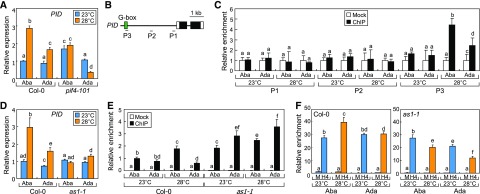Figure 5.
PIF4- and AS1-mediated developmental signals activate PID transcription in the abaxial petiole region at warm temperatures. Three independent measurements, each consisting of 16 individual plants grown under identical conditions, were statistically analyzed. Different letters represent significant differences (P < 0.01) determined by one-way ANOVA with posthoc Tukey’s test. Error bars indicate se (A and D) or sd (C, E, and F). A, PID transcription in the pif4-101 mutant. Three-week-old plants were exposed to 28°C for 6 h. Transcript levels were analyzed by RT-qPCR. B, Genomic structure of the PID locus. Black boxes are exons, and white boxes are 5′ and 3′ untranslated regions. The P1 to P3 sequences were analyzed in ChIP assays. C, PIF4 binding to the PID promoter. Three-week-old plants expressing a PIF4-FLAG fusion driven by the endogenous PIF4 promoter were exposed to 28°C for 6 h. ChIP assays were performed using an anti-FLAG antibody. D, Transcription of the PID gene in as1-1 leaf petioles. Transcript levels were analyzed by RT-qPCR. E, PIF4 binding to the PID promoter in the as1-1 mutant. A PIF4-FLAG fusion was expressed driven by the endogenous PIF4 promoter in Col-0 plants and the as1-1 mutant. The P3 sequence was used in the assay. F, H4 acetylation in PID chromatin. ChIP assays were performed using either Col-0 or as1-1 leaf petioles. An anti-H4Ac antibody was used for immunoprecipitation. H4 acetylation was analyzed by ChIP-qPCR. M, Mock.

